The women who marched in 2018
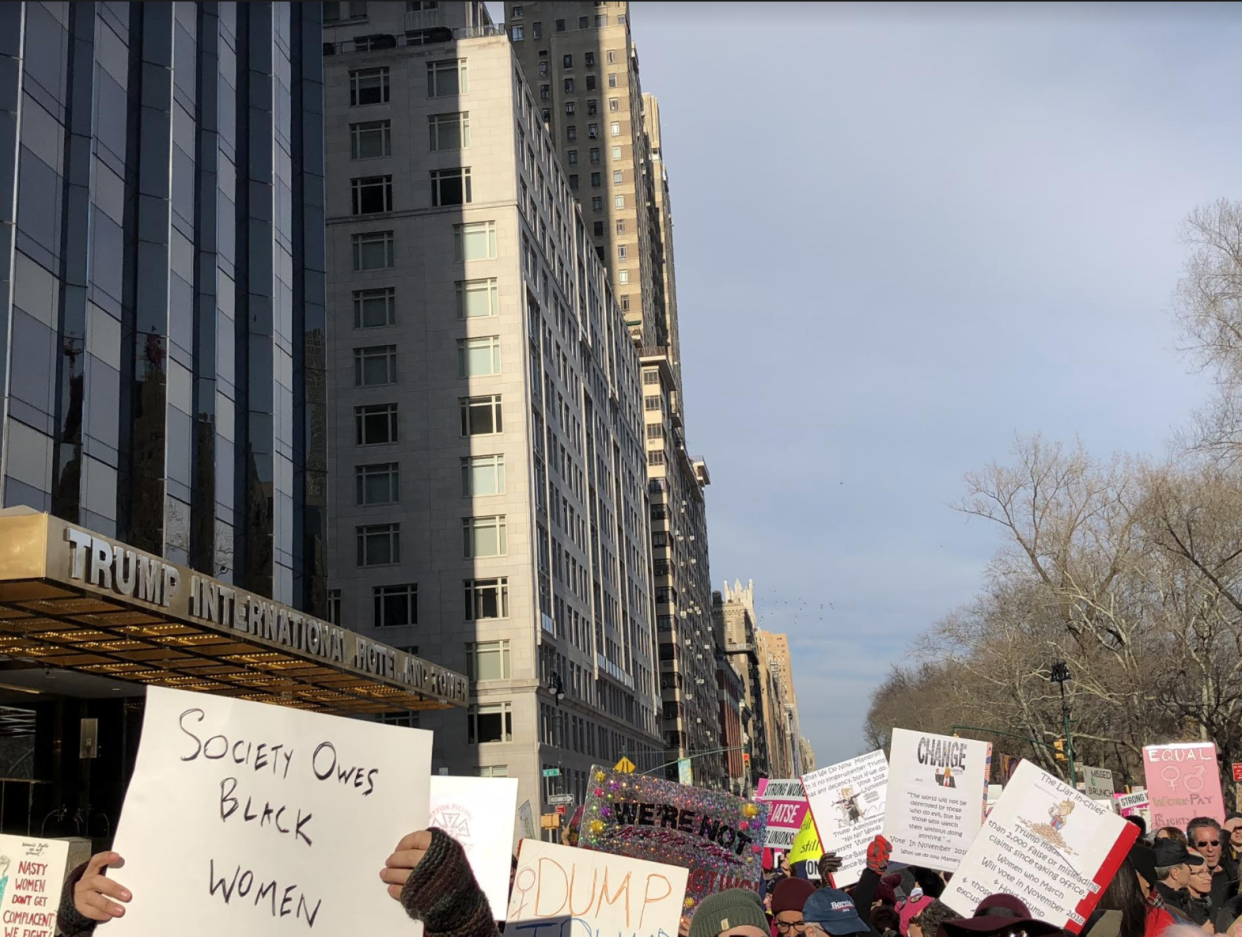
The marchers stretched for 30 city blocks along Central Park West, from its starting point in front of the Trump International Hotel at 59th Street all the way back to the Museum of Natural History at 86th. The crowd filled the side streets along that stretch too. They stood shoulder to shoulder on 71st and 75th, waiting for the police to remove the barricades so they could join the sea of people.
New York Mayor Bill de Blasio’s office estimated the crowd size as being at least 200,000 people.
The result was a stretch of bright pink hats and largely hand-drawn signs, supporting a swath of causes. The atmosphere was that of a New Orleans funeral — a mix of high spirits and deep mourning, interspersed with marching bands and a smattering of costumes. Down Central Park West it wound, onto Sixth Avenue, ending at Bryant Park in midtown.

Diane Carlson and Roseanne Ryan took a train from Stony Brook University at 7:40 a.m. and headed for the hotel room they had booked in Manhattan for that night. They had been at last year’s march in Washington, and anticipating similar crowds here, they decided to stay overnight rather than fight traffic going home.
They put their sign together at the hotel. “Make America Kind Again,” it read. There would have been a picture too — of the Statue of Liberty kicking Donald Trump with her boot — but they forgot to pack it, and once at the march they decided that was for the best. “It wasn’t the kindest image,” Carlson said. “Now this is a completely kind sign.”

Other sign makers were not as concerned with being kind. Using the president’s “own language,” flight attendant Jonni Lane drew a picture of Trump with the poop emoji spewing from his mouth. “S***hole-N-Chief,” it read, and was one of hundreds of curse-filled signs held by marchers. “It’s been a rough year,” Lane said of her reasons for marching. “I’m here to protest, to make my voice heard, to vent. A little shouting never hurt anyone.”
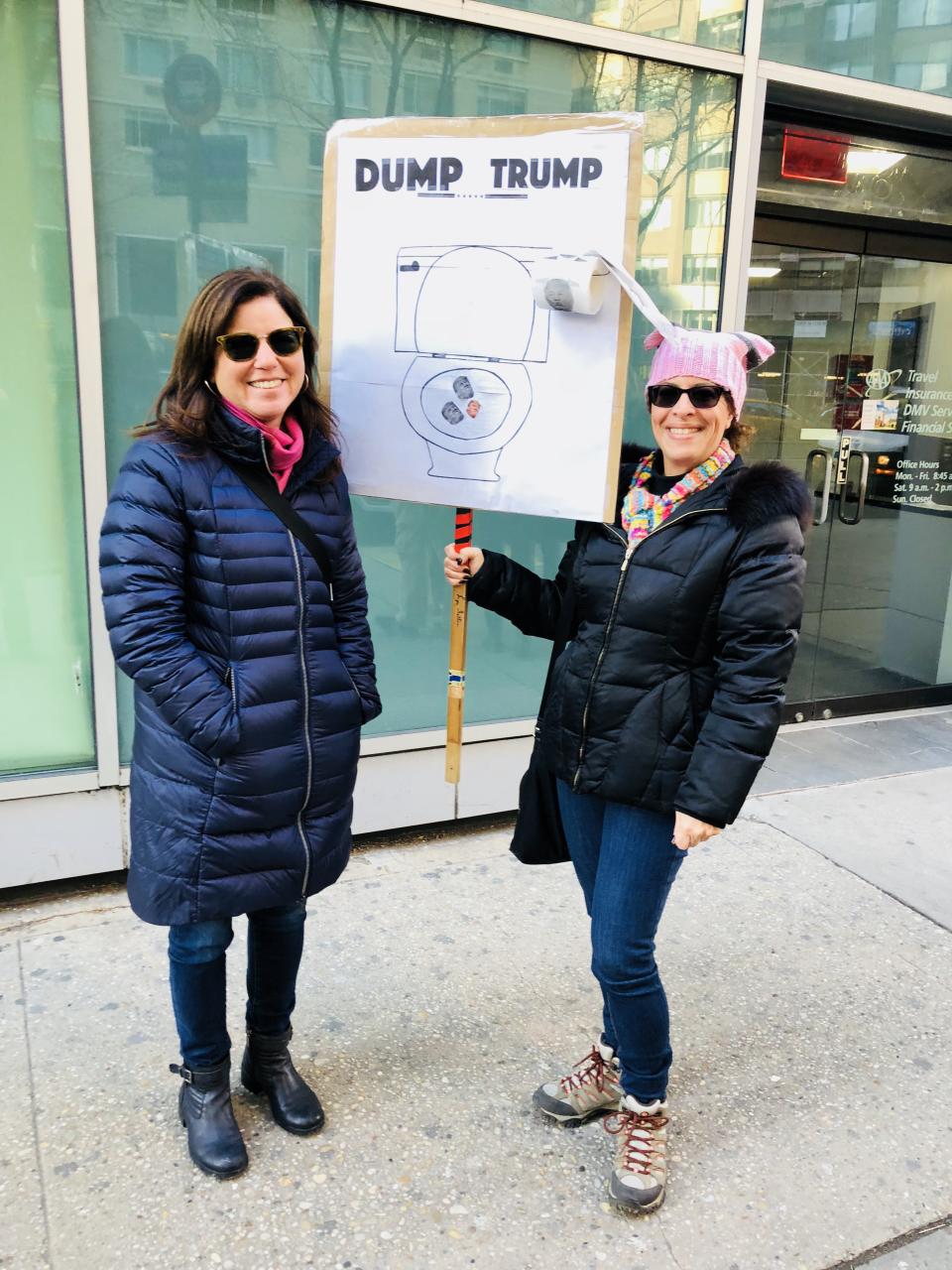
More complicated, but on the same theme, was the “Dump Trump” sign carried by Evy Lieberman and her friend Nancy Gillon, who had driven in from Tenafly, N.J. Attached to the sign was an actual roll of toilet paper, each sheet of which carried a picture of the president.
“I’m here because she marched last year and said it was an incredible experience surrounded by all those determined people,” Gillon said, pointing to Lieberman. “I needed to experience some of that energy.”
“And I needed to get it back,” Lieberman said. “I’m here because I’ve been miserable.”

Officially, march organizers are describing the events taking place in cities around the country and the world as “marches” rather than “protests” — and they stress that the purpose is to encourage voter participation in the 2018 midterm elections and beyond.
In that spirit, Yisel Fernandez carried a sign that said, “I’m Hispanic, I’m a Mother, I’m a Business Owner & I Vote.” She was marching for her 2-year-old daughter, she said, whom she was going to bring but decided to leave at home because, despite the unseasonably warm high of 51 degrees, it was still “really cold” for a toddler.
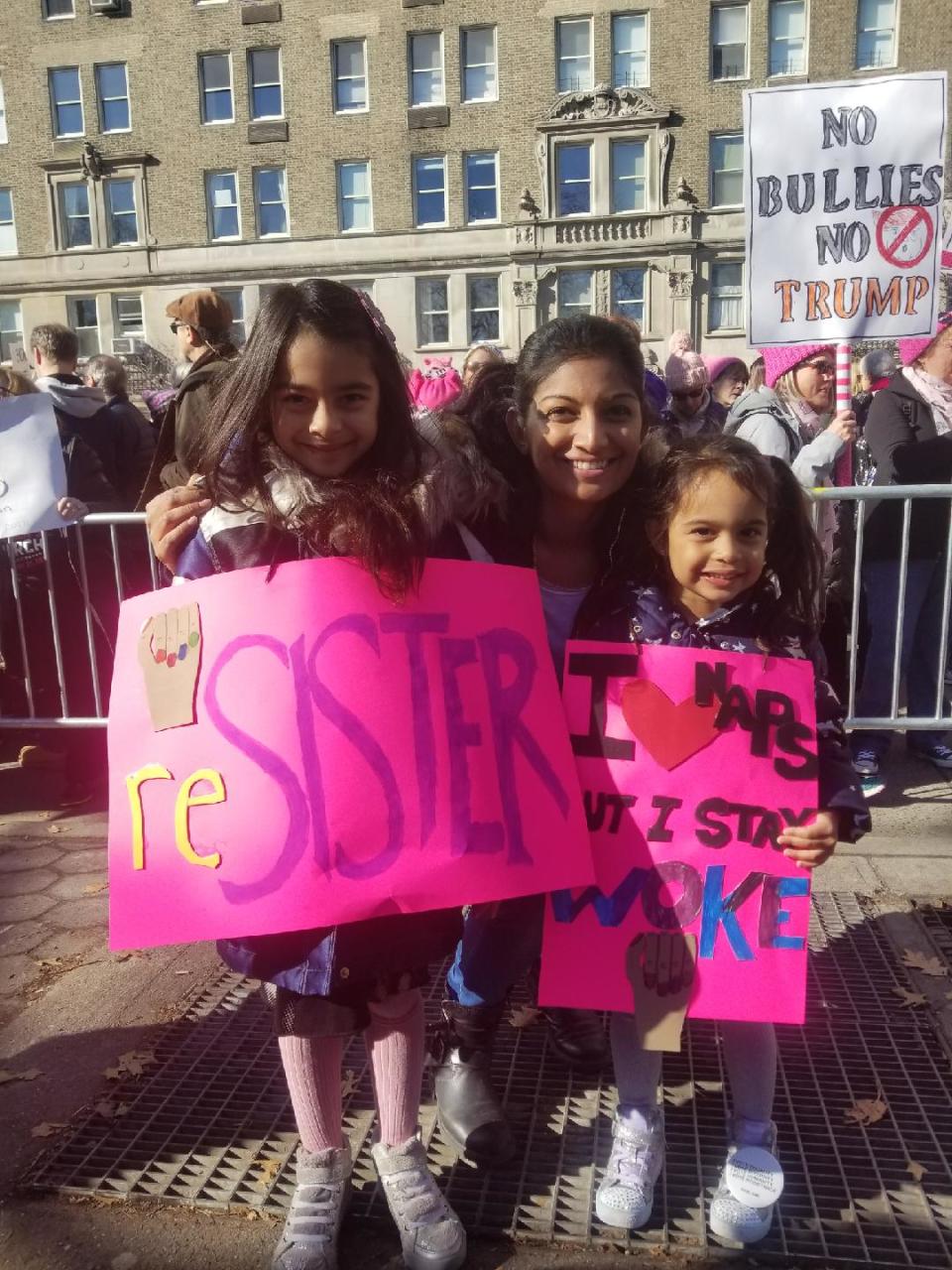
Loveena Rajanayakam was also marching for her young daughters, and she brought them along, bundled up in matching purple winter coats. Together they held signs that read, “ReSISTER” and “I Love Naps But I Stay Woke.”
“It’s very important for them to understand that they can do anything, shouldn’t take anything for granted, and have a voice that needs to be heard,” she said.
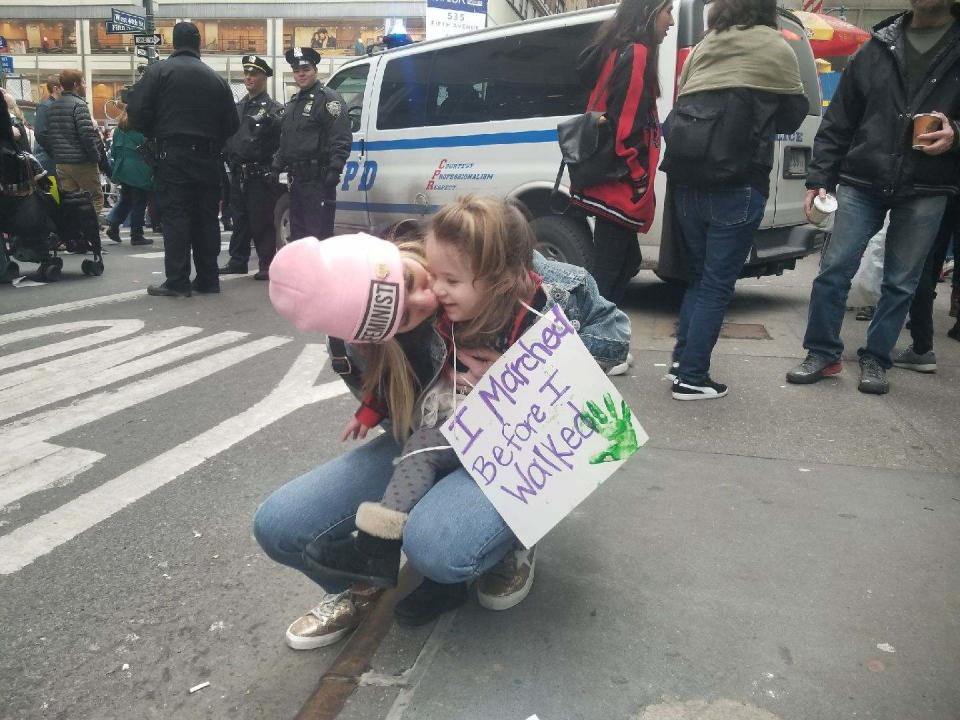
And Amanda Hambrick was marching with 1-year-old Skylar, who was kind of marching for herself. The toddler did her best to toddle along with her mother with a sign around her neck that read, “I marched before I walked.”
Asked why she was marching, Hambrick said, “We’ve got to show up for each other. There’s too much at stake.”

In a marvel of logistics, large groups of marchers managed to meet up on a variety of street corners and march together. A group of 100 Asian-Americans did so at Broadway and 69th Street, representing a collection of advocacy groups, including the Asian Women’s Network, the Korean American Service Center, and Asian Women United.
“Power to the polls, that’s our cause,” said Joyce Samoa, one of the marchers. “We want Asian-American women to start voting. We are the poorest group in New York City, and we are underrepresented on the voter rolls and in public office.”

Ann Marie Morris, Barbara Spitzer, and Marc Allen stopped on their way to the march to shop. They already had their signs. “Truth, We Miss You,” Allen’s read; “Build A Wall Around Trump! I’ll Pay For It,” read Morris’s.
But they added messages from one of the many button vendors lining the sidewalks. “Go Fact Yourself,” read one purchase. “Michelle Obama 2020” said another.
“He’s a disgrace, he’s an embarrassment,” Morris said of why she was marching. “We wouldn’t accept this behavior from a CEO, a Hollywood actor; no one else is allowed to act like this.”

Lois Hoffmann turned 80 this year, and the Women’s March was “on my bucket list,” she says. So her daughters brought her down from her New Hampshire home to protest.
“There is no force more powerful than a woman determined,” read her sign, which she held while her daughter Catherine Sorenson pushed her wheelchair.
“Not this Grandma’s President,” read Janet Mehan’s as she walked next to her.
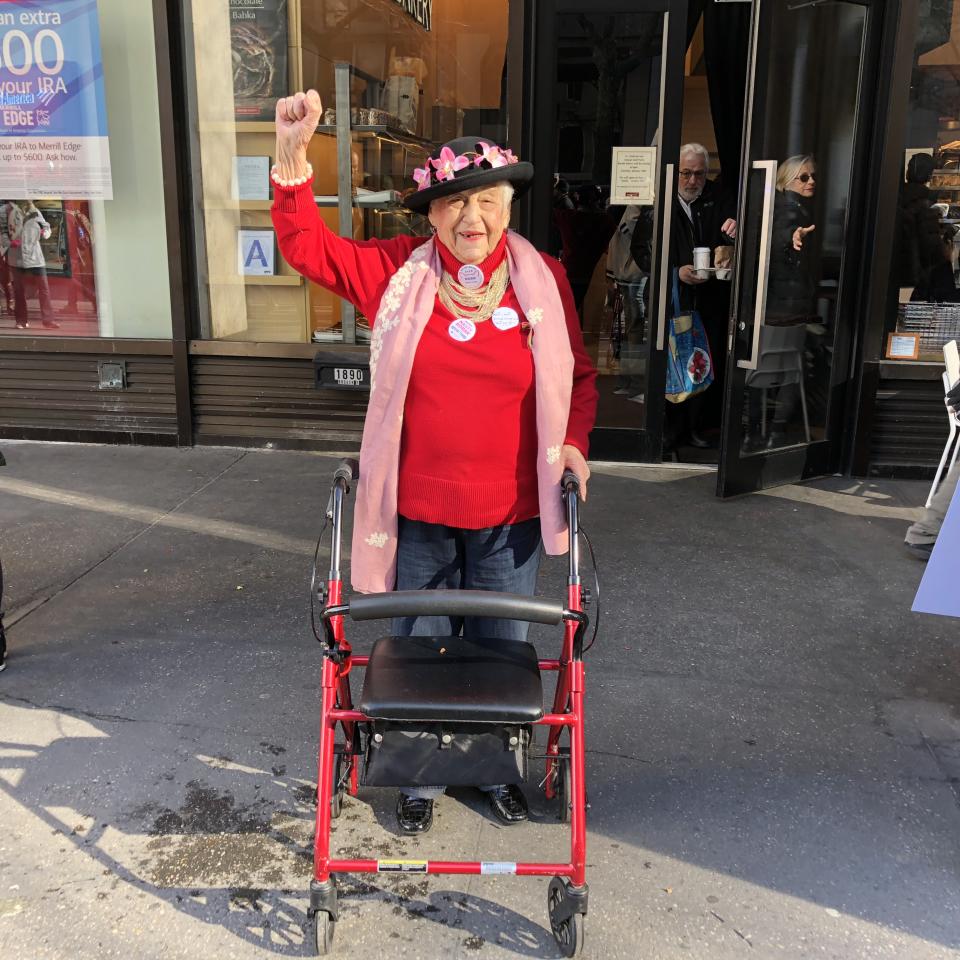
There was no one keeping track, but odds are that Ruth Rosar was the oldest marcher present in New York City. She was born on March 3, 1916, she said, making her almost 102 years old.
Her mother was a suffragette, marching for the women’s vote, and now Rosar was decked all in red, wearing a button that said, “Another Nasty Woman Against Trump,” and attracting a crowd.
“I have been watching Donald Trump and the 68 million people who voted for him tear down our nation, agency by agency. I can’t really march,” she said, pointing to her walker and explaining that she would spend the day on a quieter sidewalk greeting passersby. “But I can be here.”

Women like Rosar were on Ana Lombardo’s mind as she marched. “Grateful to the Women Before Me Who Fought For My Rights,” her sign read.
Others were on her mind as well. On one side of her sign’s handle she had attached a photo of her friend Christine, who died of breast cancer three years ago, and “who would have absolutely been here,” Lombardo said.
And on the other side was a photo of her friend Sal, who died of AIDS less than a year ago. Sal was too sick to attend the 2017 march with Lombardo, but she carried his photo there as well. “And he made me promise that if I went this year, I would take him with me in spirit again,” she said.
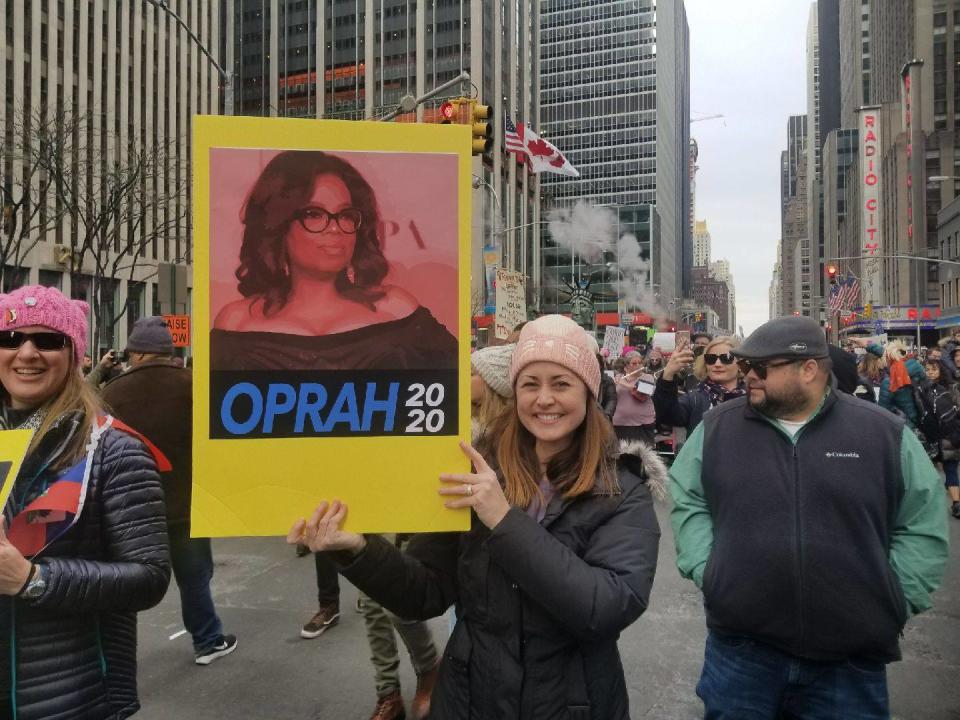
A different woman was in Shawn Gutcheff’s mind — and on her sign. She brought a poster of Oprah Winfrey with her from Salt Lake City because, she said, “I’m marching for Oprah. For everything that is the antithesis of Donald Trump.”
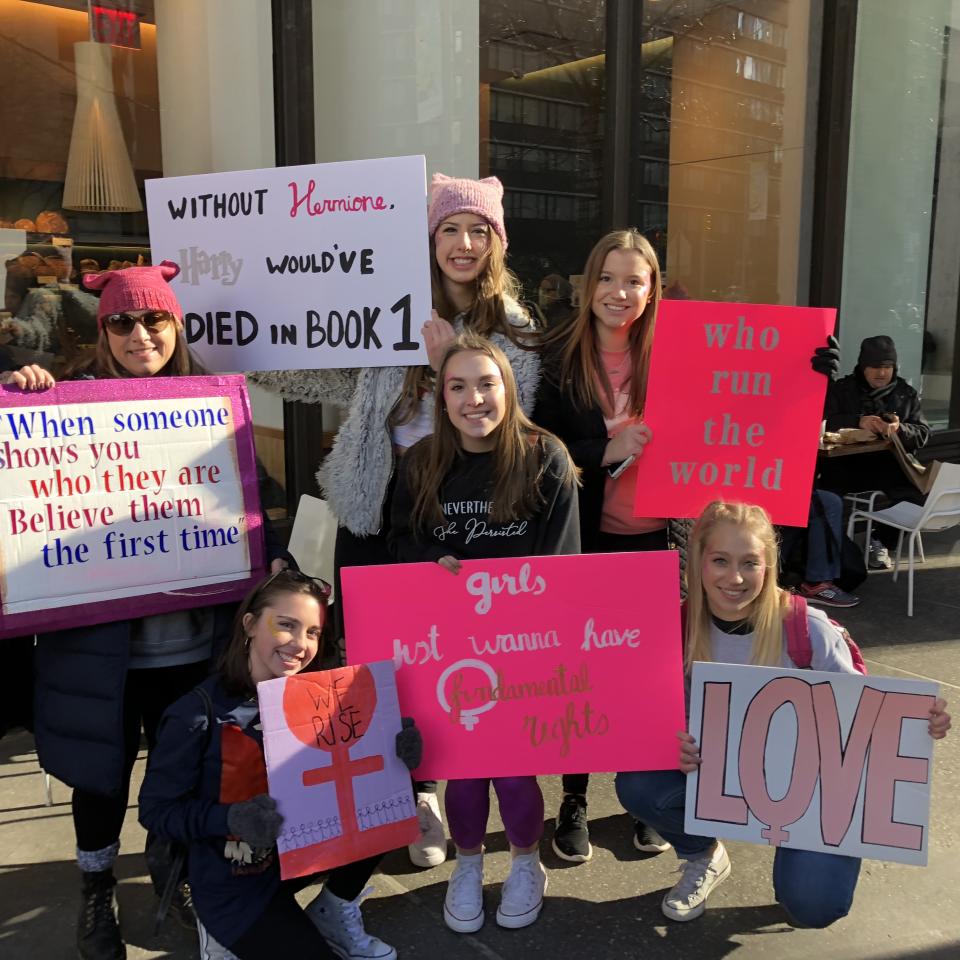
Mya Stein, Ally Dolmanisth, Haley Prisloe and Kate Gregory are all 17 years old and will all vote for the first time this year. They take that responsibility seriously, they say, and came to march so that others would register.
“I think our generation needs to experience these things so that we can build our own future,” said Dolmanisth’s 15-year-old sister, Sophie. So the group put sparkly face paint on their cheeks and used bright colors on their signs.
“Without Hermione, Harry Would Have Died in Book 1,” read Stein’s.
“Girls Just Want to Have FUNdamental Rights,” read Dolmanisth’s.
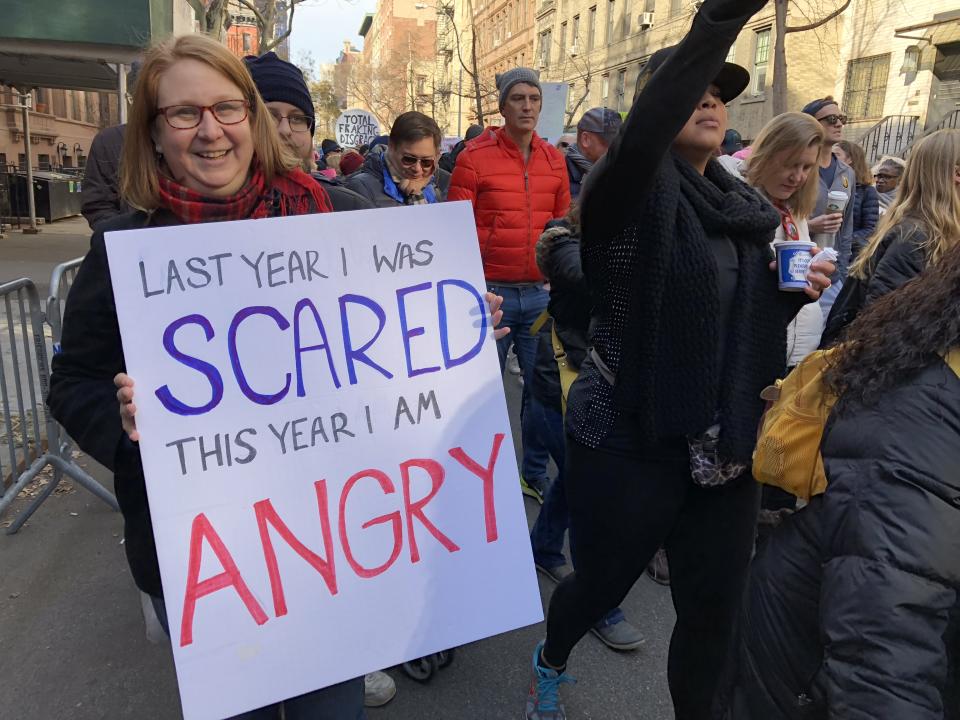
Many of the marchers were second-timers, having participated in the 2017 march in New York or elsewhere.
Susan Ferziger was one of those, and now she was back carrying a sign that said, “Last Year I Was Scared, This Year I Am Angry.”
“It’s worse than I’d feared,” she said, listing more than a dozen administration actions with which she disagreed. “So I’m back.”

It was also not Charise Fisher’s first march. When she was 12, her mother brought her to a protest against South African apartheid, and she says, “I will never forget the day Nelson Mandela got out of jail.” To carry on the legacy of protest, she brought her daughters, 7-year-old Nina and 9-year-old Lauren, along today.
“As black women, we stand on the legacy of the people who marched before,” she said. “So this generation has to continue marching.”

All along the route there were political conversations, and one of the more common themes was exactly what these large gatherings of protesters actually accomplished.
Clarissa Rodriguez and Eliza Mendel, both classmates from SUNY Purchase in Westchester, said they were marching because they believed in the power of hundreds of thousands of voices.
“People said last year that the Women’s March wasn’t going to do anything, it wouldn’t change anything,” Rodriguez said. “But it created real action — the #MeToo movement, the voter registration drives, all those women running for office.”

Ellie Engstram, who traveled to the march from Ohio, also agreed that there was value in the gathering. If nothing else, she said, being together in one place was reinforcing for those who participated.
“It’s important to get together to have our voices heard and to have conversations rather than just tweeting,” she said, carrying a sign that read, “Liberty Is a Lady for a Reason.”
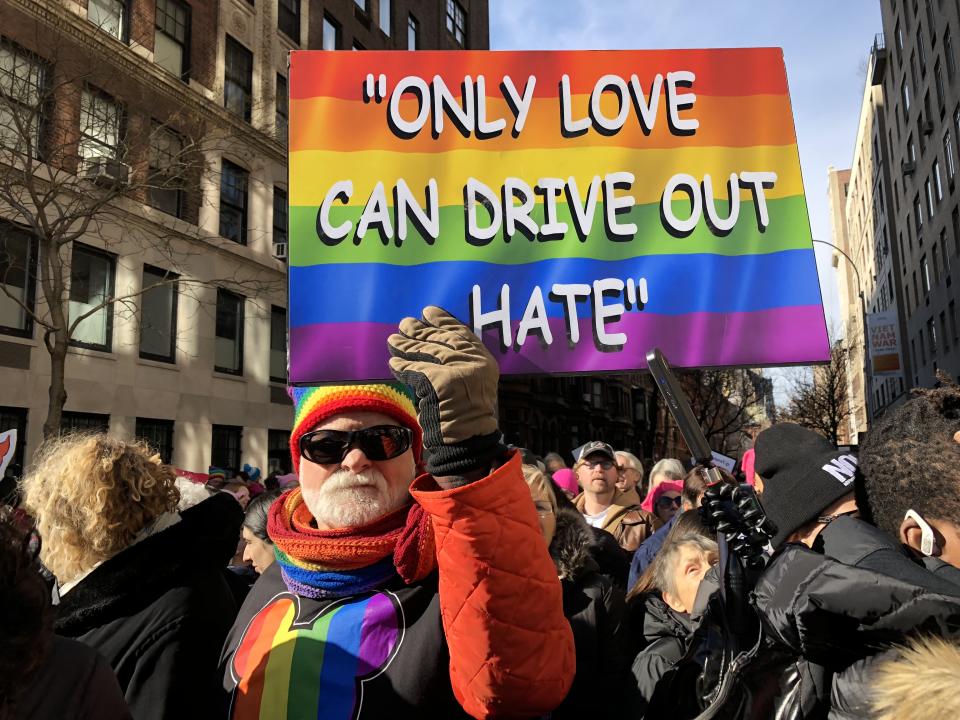
John Cadue was dressed head to toe in rainbows, carrying a sign that said, “Only Love Can Drive Out Hate.”
When asked why he was marching, he swept his hand down the length of his multicolor-clad body and said, “Doesn’t this speak for itself? Activism is alive and well.”
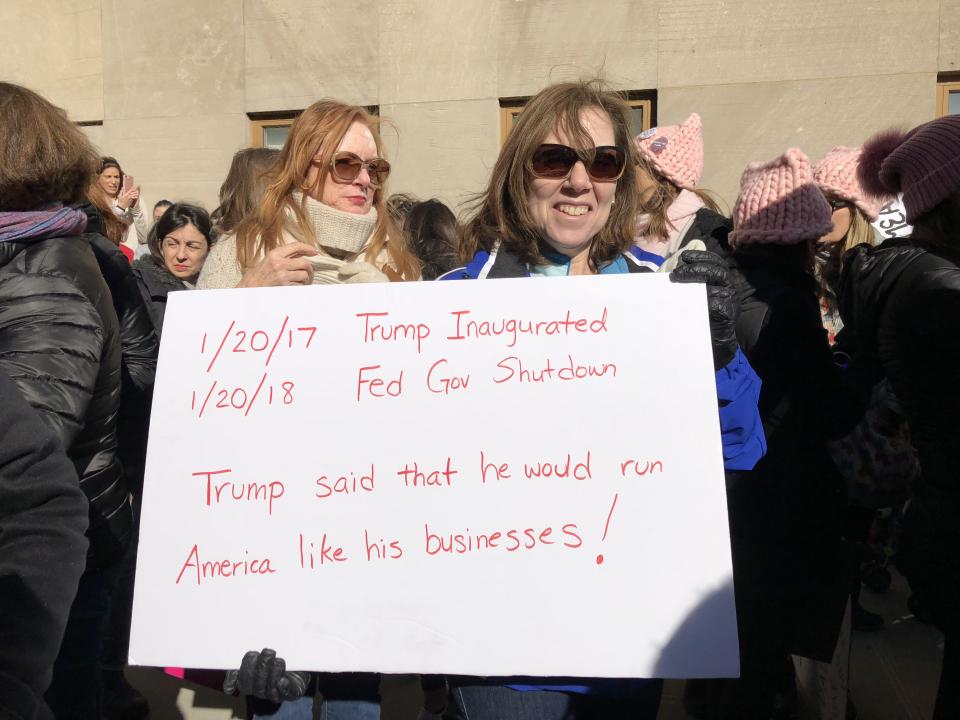
Cheryl Snow wasn’t sure what sign she would carry today. Then she woke up to the morning news and was certain.
“1/20/17 Trump Inaugurated, 1/20/18 Fed Gov Shutdown,” she wrote in red marker on white posterboard. “Trump said that he would run America like his businesses.”
Her friend Doria Bachenheimer, who carried that sign, said that she and Snow were marching for many reasons — “for human rights, for basic human decency, for democracy…”
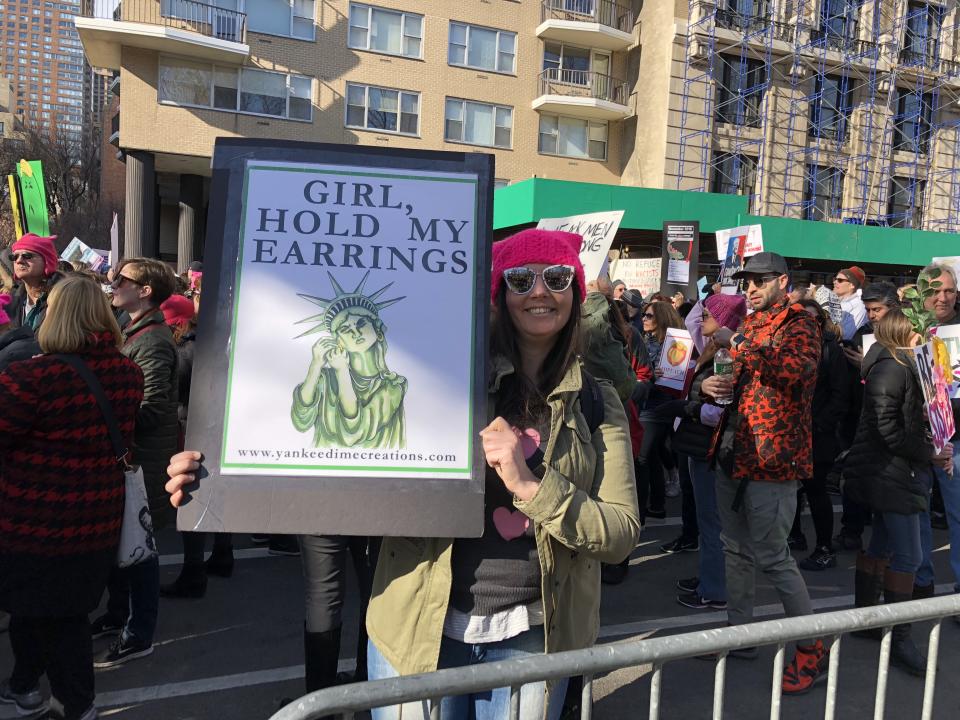
Artist Monica Martino realizes that she has made a nice living off of Donald Trump. A year ago, the Atlanta native painted a poster showing a ripe orange peach topped with a shock of blond hair and the message “ImPeach.” She put it on her website and has sold quite a few.
This year, her poster has a picture of the Statue of Liberty and the message “Girl, Hold My Earrings,” as Lady Liberty prepares for a fight. She put her web address on the poster and figures she will sell a number of these images too.
“It’s good for business but terrible for my morale,” she said of the current administration. “I want to put myself out of business. I want to go back to drawing animals and other cute stuff.”

On the sidewalk along Central Park South, as a stream of marchers passed by, Virginie Valeama and her brand new husband, Cochan Yves, stood confused.
She was in her white gown, he was in his brown suit, and they were headed for Central Park to take wedding photos immediately after their ceremony when they encountered quite a crowd.
From a French island off the coast of Madagascar, they had come 20,000 kilometers to be married in New York but had not heard there would be another big event that day.
“What is this for?” Virginie asked. “It’s against Trump,” a passerby told her. Bride and groom smiled and pumped their fists.

Two hours after the march first began to move, with no end in sight, Candy Fitts and Barbara Posner, both from Connecticut, stood watching from the sidewalk wearing the ubiquitous pink “pussy hats” and holding a sign that read, “We’re Still Here! 2018.”
They were already thinking of next Jan. 20 and wondering whether there would be a need to march again. They were fairly sure there would — that the march represented a real change in the political landscape and those who were marching, once emboldened, would not go quietly back to their former lives.
“Our message is that we’re not going away; nobody’s giving up,” Posner said. “This will continue until we’re heard.”
Read more from Yahoo News:

